Policy Brief: Bridging Science and Policy in Water Resource Management
VerifiedAdded on 2023/01/19
|11
|2717
|53
Report
AI Summary
This policy brief, authored by a student, addresses the critical issues surrounding water resource management. It begins with an executive summary highlighting the growing pressures on water resources and the need for evidence-based policy. The brief outlines the scope of the problem, emp...
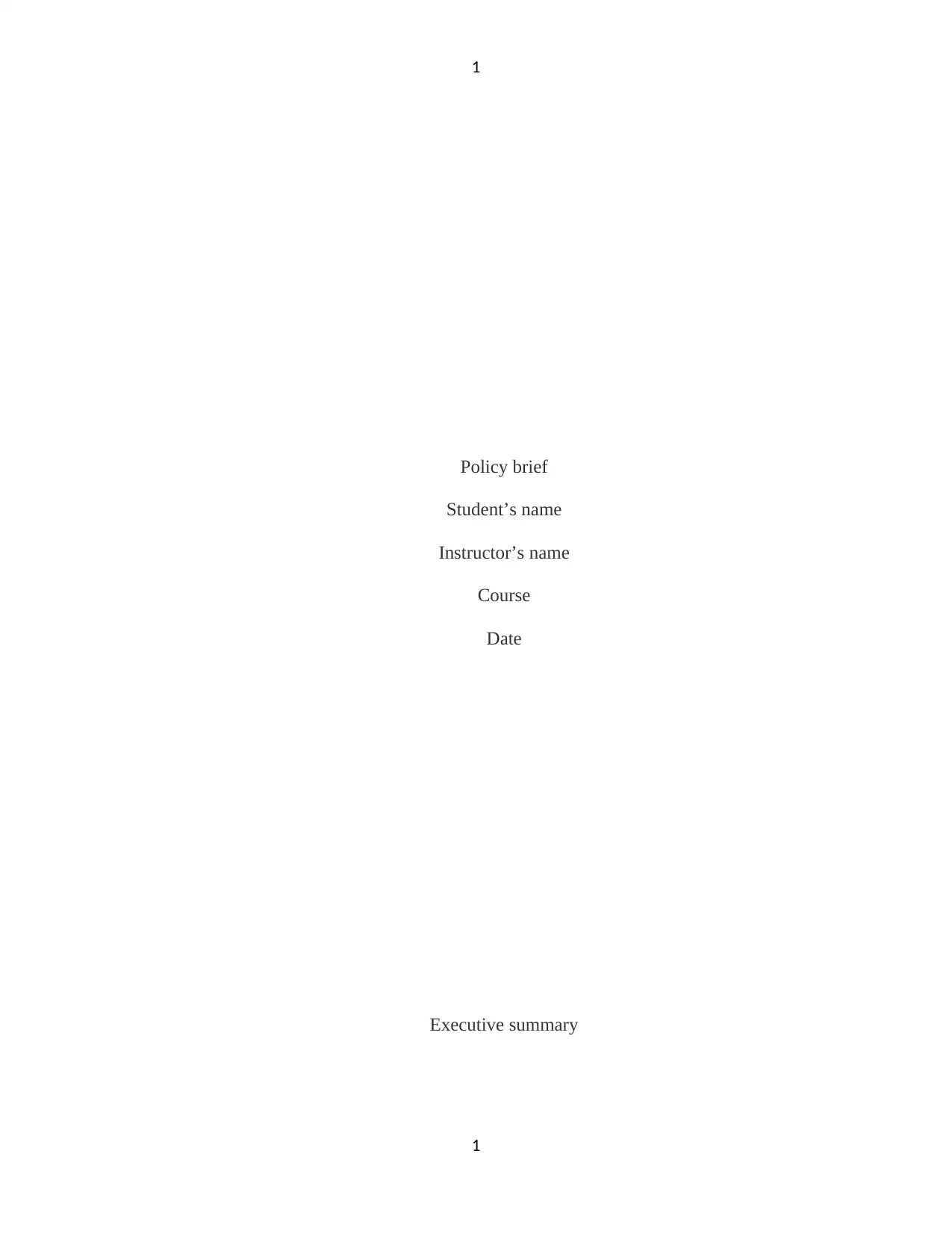
1
Policy brief
Student’s name
Instructor’s name
Course
Date
Executive summary
1
Policy brief
Student’s name
Instructor’s name
Course
Date
Executive summary
1
Paraphrase This Document
Need a fresh take? Get an instant paraphrase of this document with our AI Paraphraser
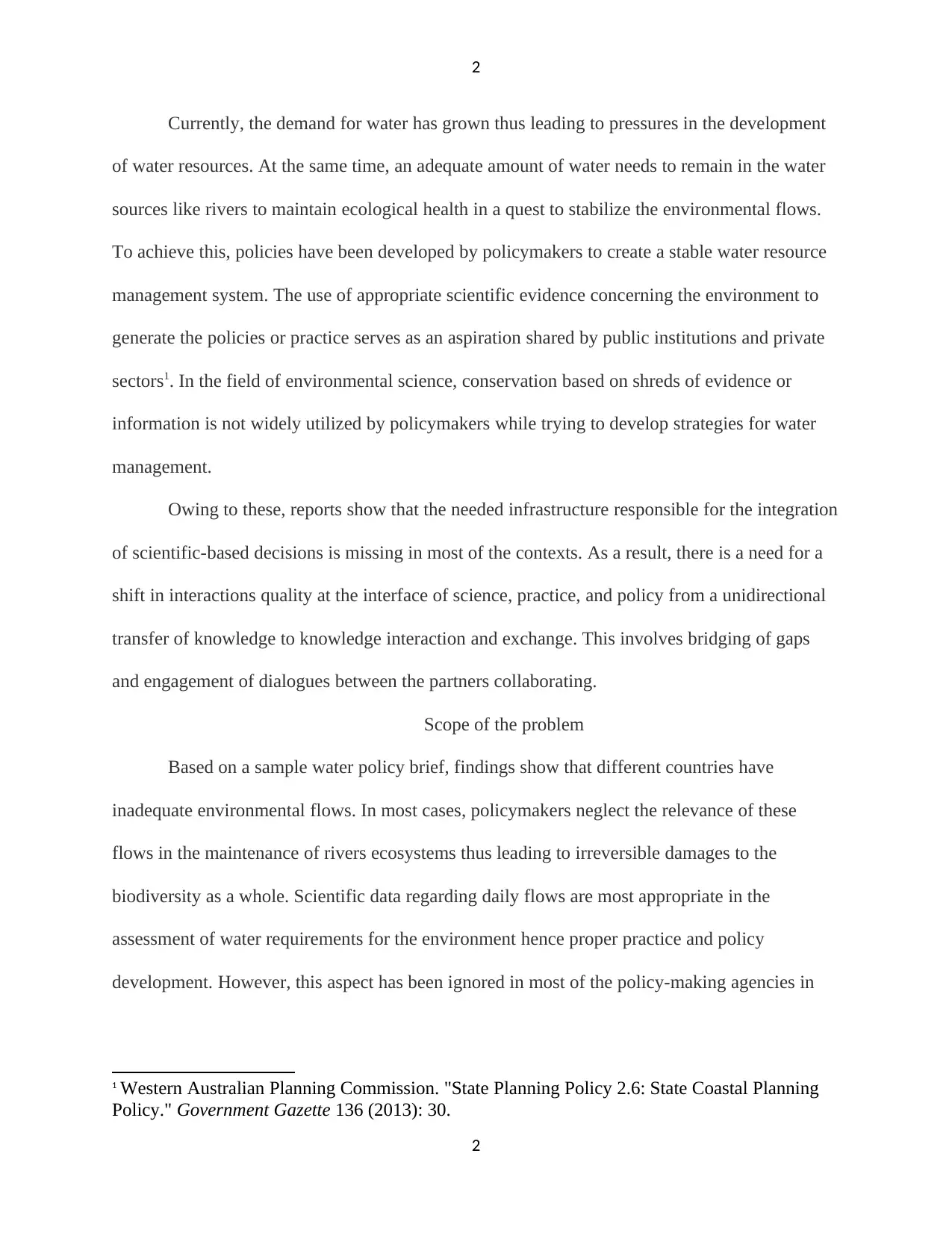
2
Currently, the demand for water has grown thus leading to pressures in the development
of water resources. At the same time, an adequate amount of water needs to remain in the water
sources like rivers to maintain ecological health in a quest to stabilize the environmental flows.
To achieve this, policies have been developed by policymakers to create a stable water resource
management system. The use of appropriate scientific evidence concerning the environment to
generate the policies or practice serves as an aspiration shared by public institutions and private
sectors1. In the field of environmental science, conservation based on shreds of evidence or
information is not widely utilized by policymakers while trying to develop strategies for water
management.
Owing to these, reports show that the needed infrastructure responsible for the integration
of scientific-based decisions is missing in most of the contexts. As a result, there is a need for a
shift in interactions quality at the interface of science, practice, and policy from a unidirectional
transfer of knowledge to knowledge interaction and exchange. This involves bridging of gaps
and engagement of dialogues between the partners collaborating.
Scope of the problem
Based on a sample water policy brief, findings show that different countries have
inadequate environmental flows. In most cases, policymakers neglect the relevance of these
flows in the maintenance of rivers ecosystems thus leading to irreversible damages to the
biodiversity as a whole. Scientific data regarding daily flows are most appropriate in the
assessment of water requirements for the environment hence proper practice and policy
development. However, this aspect has been ignored in most of the policy-making agencies in
1 Western Australian Planning Commission. "State Planning Policy 2.6: State Coastal Planning
Policy." Government Gazette 136 (2013): 30.
2
Currently, the demand for water has grown thus leading to pressures in the development
of water resources. At the same time, an adequate amount of water needs to remain in the water
sources like rivers to maintain ecological health in a quest to stabilize the environmental flows.
To achieve this, policies have been developed by policymakers to create a stable water resource
management system. The use of appropriate scientific evidence concerning the environment to
generate the policies or practice serves as an aspiration shared by public institutions and private
sectors1. In the field of environmental science, conservation based on shreds of evidence or
information is not widely utilized by policymakers while trying to develop strategies for water
management.
Owing to these, reports show that the needed infrastructure responsible for the integration
of scientific-based decisions is missing in most of the contexts. As a result, there is a need for a
shift in interactions quality at the interface of science, practice, and policy from a unidirectional
transfer of knowledge to knowledge interaction and exchange. This involves bridging of gaps
and engagement of dialogues between the partners collaborating.
Scope of the problem
Based on a sample water policy brief, findings show that different countries have
inadequate environmental flows. In most cases, policymakers neglect the relevance of these
flows in the maintenance of rivers ecosystems thus leading to irreversible damages to the
biodiversity as a whole. Scientific data regarding daily flows are most appropriate in the
assessment of water requirements for the environment hence proper practice and policy
development. However, this aspect has been ignored in most of the policy-making agencies in
1 Western Australian Planning Commission. "State Planning Policy 2.6: State Coastal Planning
Policy." Government Gazette 136 (2013): 30.
2
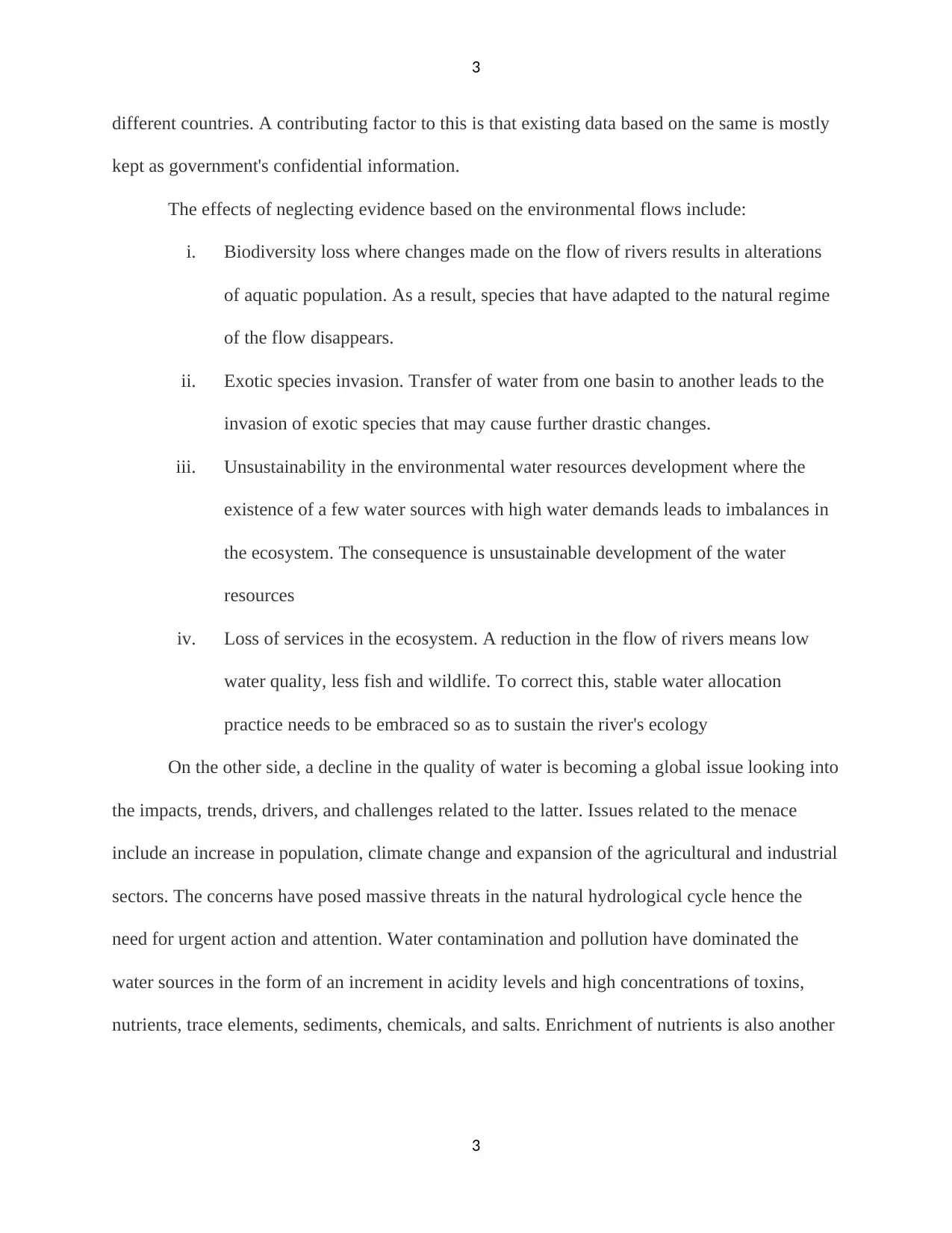
3
different countries. A contributing factor to this is that existing data based on the same is mostly
kept as government's confidential information.
The effects of neglecting evidence based on the environmental flows include:
i. Biodiversity loss where changes made on the flow of rivers results in alterations
of aquatic population. As a result, species that have adapted to the natural regime
of the flow disappears.
ii. Exotic species invasion. Transfer of water from one basin to another leads to the
invasion of exotic species that may cause further drastic changes.
iii. Unsustainability in the environmental water resources development where the
existence of a few water sources with high water demands leads to imbalances in
the ecosystem. The consequence is unsustainable development of the water
resources
iv. Loss of services in the ecosystem. A reduction in the flow of rivers means low
water quality, less fish and wildlife. To correct this, stable water allocation
practice needs to be embraced so as to sustain the river's ecology
On the other side, a decline in the quality of water is becoming a global issue looking into
the impacts, trends, drivers, and challenges related to the latter. Issues related to the menace
include an increase in population, climate change and expansion of the agricultural and industrial
sectors. The concerns have posed massive threats in the natural hydrological cycle hence the
need for urgent action and attention. Water contamination and pollution have dominated the
water sources in the form of an increment in acidity levels and high concentrations of toxins,
nutrients, trace elements, sediments, chemicals, and salts. Enrichment of nutrients is also another
3
different countries. A contributing factor to this is that existing data based on the same is mostly
kept as government's confidential information.
The effects of neglecting evidence based on the environmental flows include:
i. Biodiversity loss where changes made on the flow of rivers results in alterations
of aquatic population. As a result, species that have adapted to the natural regime
of the flow disappears.
ii. Exotic species invasion. Transfer of water from one basin to another leads to the
invasion of exotic species that may cause further drastic changes.
iii. Unsustainability in the environmental water resources development where the
existence of a few water sources with high water demands leads to imbalances in
the ecosystem. The consequence is unsustainable development of the water
resources
iv. Loss of services in the ecosystem. A reduction in the flow of rivers means low
water quality, less fish and wildlife. To correct this, stable water allocation
practice needs to be embraced so as to sustain the river's ecology
On the other side, a decline in the quality of water is becoming a global issue looking into
the impacts, trends, drivers, and challenges related to the latter. Issues related to the menace
include an increase in population, climate change and expansion of the agricultural and industrial
sectors. The concerns have posed massive threats in the natural hydrological cycle hence the
need for urgent action and attention. Water contamination and pollution have dominated the
water sources in the form of an increment in acidity levels and high concentrations of toxins,
nutrients, trace elements, sediments, chemicals, and salts. Enrichment of nutrients is also another
3
You're viewing a preview
Unlock full access by subscribing today!
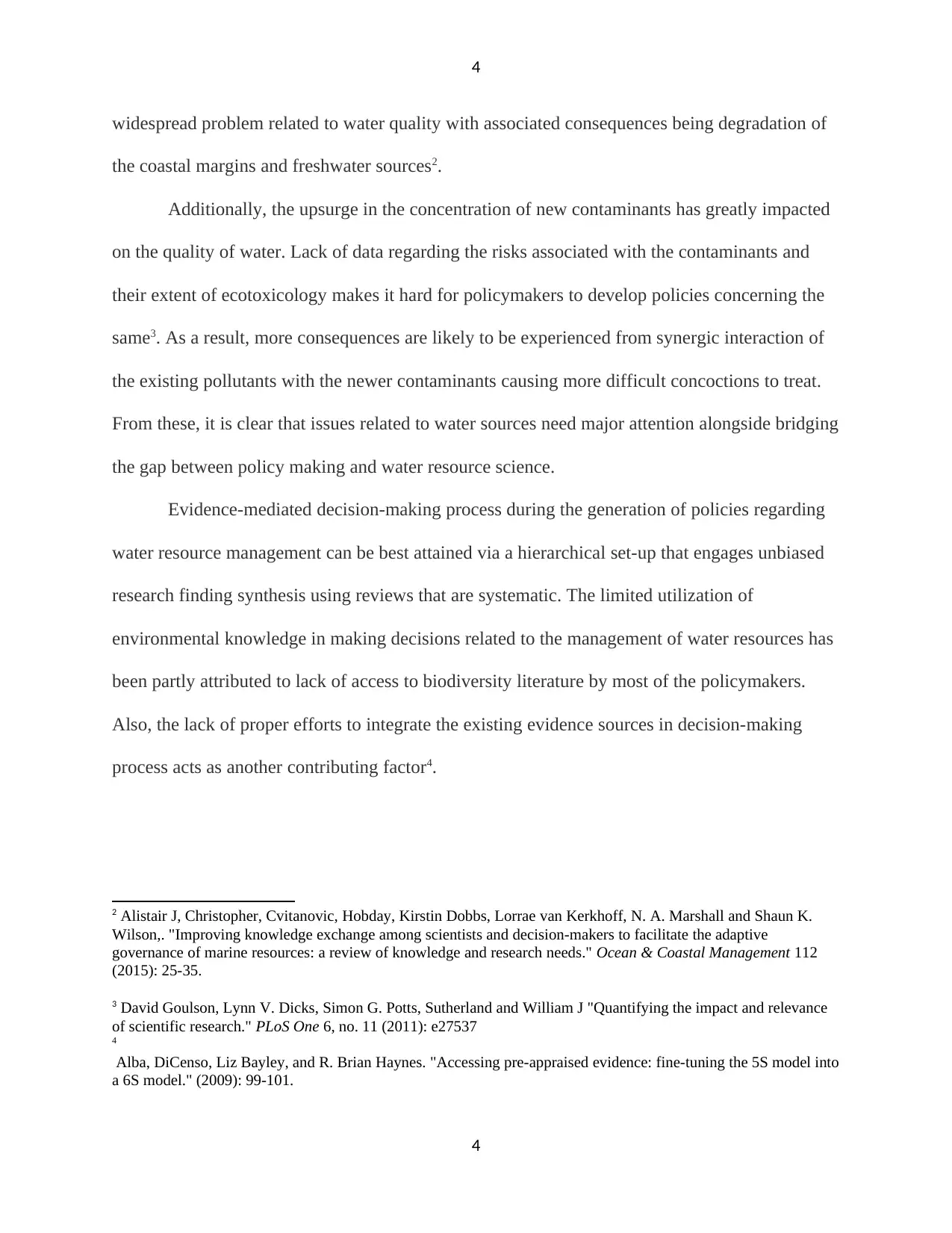
4
widespread problem related to water quality with associated consequences being degradation of
the coastal margins and freshwater sources2.
Additionally, the upsurge in the concentration of new contaminants has greatly impacted
on the quality of water. Lack of data regarding the risks associated with the contaminants and
their extent of ecotoxicology makes it hard for policymakers to develop policies concerning the
same3. As a result, more consequences are likely to be experienced from synergic interaction of
the existing pollutants with the newer contaminants causing more difficult concoctions to treat.
From these, it is clear that issues related to water sources need major attention alongside bridging
the gap between policy making and water resource science.
Evidence-mediated decision-making process during the generation of policies regarding
water resource management can be best attained via a hierarchical set-up that engages unbiased
research finding synthesis using reviews that are systematic. The limited utilization of
environmental knowledge in making decisions related to the management of water resources has
been partly attributed to lack of access to biodiversity literature by most of the policymakers.
Also, the lack of proper efforts to integrate the existing evidence sources in decision-making
process acts as another contributing factor4.
2 Alistair J, Christopher, Cvitanovic, Hobday, Kirstin Dobbs, Lorrae van Kerkhoff, N. A. Marshall and Shaun K.
Wilson,. "Improving knowledge exchange among scientists and decision-makers to facilitate the adaptive
governance of marine resources: a review of knowledge and research needs." Ocean & Coastal Management 112
(2015): 25-35.
3 David Goulson, Lynn V. Dicks, Simon G. Potts, Sutherland and William J "Quantifying the impact and relevance
of scientific research." PLoS One 6, no. 11 (2011): e27537
4
Alba, DiCenso, Liz Bayley, and R. Brian Haynes. "Accessing pre-appraised evidence: fine-tuning the 5S model into
a 6S model." (2009): 99-101.
4
widespread problem related to water quality with associated consequences being degradation of
the coastal margins and freshwater sources2.
Additionally, the upsurge in the concentration of new contaminants has greatly impacted
on the quality of water. Lack of data regarding the risks associated with the contaminants and
their extent of ecotoxicology makes it hard for policymakers to develop policies concerning the
same3. As a result, more consequences are likely to be experienced from synergic interaction of
the existing pollutants with the newer contaminants causing more difficult concoctions to treat.
From these, it is clear that issues related to water sources need major attention alongside bridging
the gap between policy making and water resource science.
Evidence-mediated decision-making process during the generation of policies regarding
water resource management can be best attained via a hierarchical set-up that engages unbiased
research finding synthesis using reviews that are systematic. The limited utilization of
environmental knowledge in making decisions related to the management of water resources has
been partly attributed to lack of access to biodiversity literature by most of the policymakers.
Also, the lack of proper efforts to integrate the existing evidence sources in decision-making
process acts as another contributing factor4.
2 Alistair J, Christopher, Cvitanovic, Hobday, Kirstin Dobbs, Lorrae van Kerkhoff, N. A. Marshall and Shaun K.
Wilson,. "Improving knowledge exchange among scientists and decision-makers to facilitate the adaptive
governance of marine resources: a review of knowledge and research needs." Ocean & Coastal Management 112
(2015): 25-35.
3 David Goulson, Lynn V. Dicks, Simon G. Potts, Sutherland and William J "Quantifying the impact and relevance
of scientific research." PLoS One 6, no. 11 (2011): e27537
4
Alba, DiCenso, Liz Bayley, and R. Brian Haynes. "Accessing pre-appraised evidence: fine-tuning the 5S model into
a 6S model." (2009): 99-101.
4
Paraphrase This Document
Need a fresh take? Get an instant paraphrase of this document with our AI Paraphraser

5
Policy alternative
Implementation of the 4S framework to bridge the gap between policy-making and
environmental science.
Figure 1 1: a diagram showing the 4S framework.
Figure 1.1 represents a schematic diagram showing how information in environmental
science could be fit into the decision-making process to generate policies that aid in stabilizing
water resource management. Based on the set-up, primary findings are collated into reviews that
are systematic in nature. The findings and the reviews displayed as summaries and the pieces of
evidence regarding the nature and extent of water properties like contamination are placed into
the context of policymaking5. This specifically helps to prioritize threats related to wastewater
5 Collaboration for Environmental Evidence. "Guidelines for systematic review and evidence synthesis in
environmental management." (2013).
5
Policy alternative
Implementation of the 4S framework to bridge the gap between policy-making and
environmental science.
Figure 1 1: a diagram showing the 4S framework.
Figure 1.1 represents a schematic diagram showing how information in environmental
science could be fit into the decision-making process to generate policies that aid in stabilizing
water resource management. Based on the set-up, primary findings are collated into reviews that
are systematic in nature. The findings and the reviews displayed as summaries and the pieces of
evidence regarding the nature and extent of water properties like contamination are placed into
the context of policymaking5. This specifically helps to prioritize threats related to wastewater
5 Collaboration for Environmental Evidence. "Guidelines for systematic review and evidence synthesis in
environmental management." (2013).
5
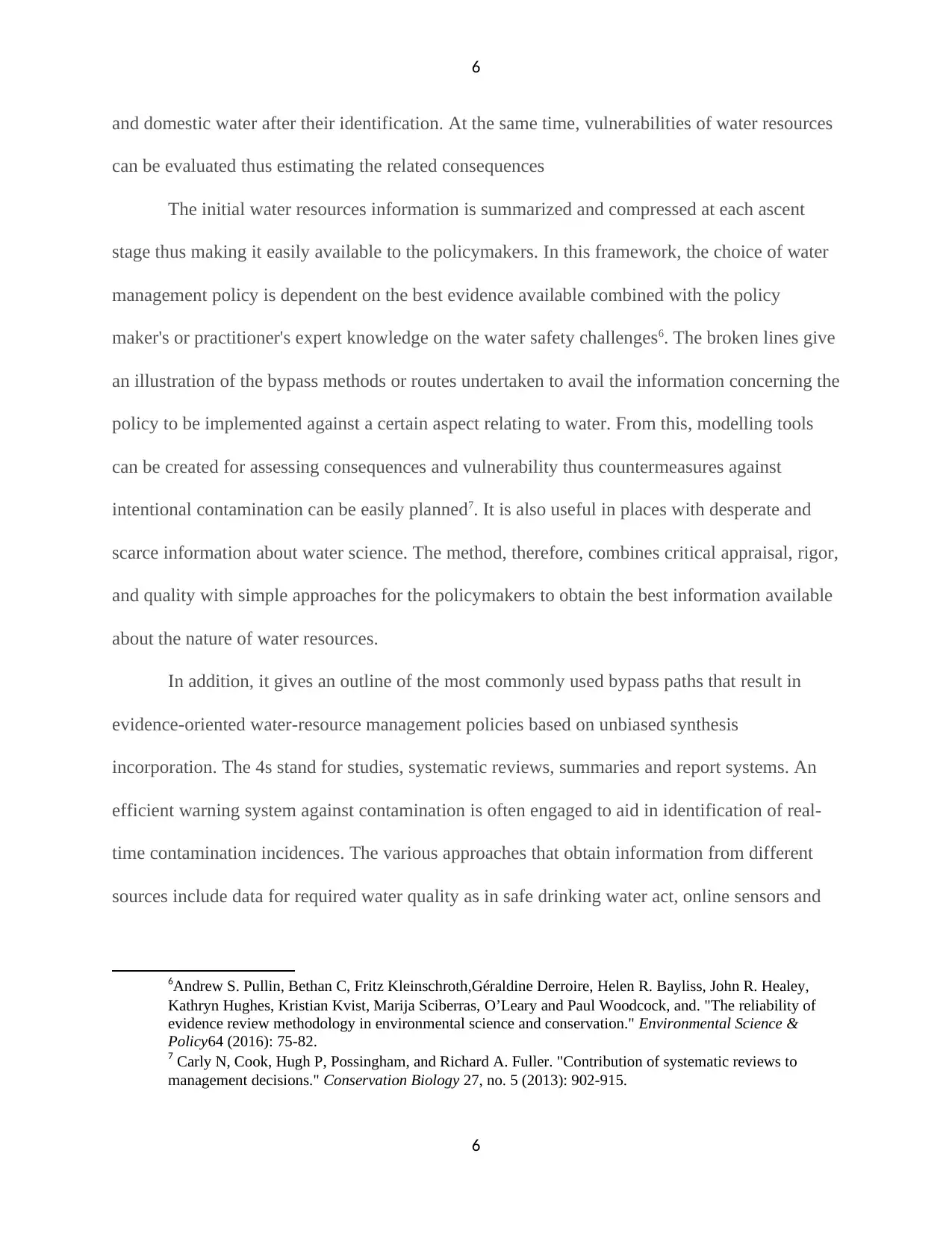
6
and domestic water after their identification. At the same time, vulnerabilities of water resources
can be evaluated thus estimating the related consequences
The initial water resources information is summarized and compressed at each ascent
stage thus making it easily available to the policymakers. In this framework, the choice of water
management policy is dependent on the best evidence available combined with the policy
maker's or practitioner's expert knowledge on the water safety challenges6. The broken lines give
an illustration of the bypass methods or routes undertaken to avail the information concerning the
policy to be implemented against a certain aspect relating to water. From this, modelling tools
can be created for assessing consequences and vulnerability thus countermeasures against
intentional contamination can be easily planned7. It is also useful in places with desperate and
scarce information about water science. The method, therefore, combines critical appraisal, rigor,
and quality with simple approaches for the policymakers to obtain the best information available
about the nature of water resources.
In addition, it gives an outline of the most commonly used bypass paths that result in
evidence-oriented water-resource management policies based on unbiased synthesis
incorporation. The 4s stand for studies, systematic reviews, summaries and report systems. An
efficient warning system against contamination is often engaged to aid in identification of real-
time contamination incidences. The various approaches that obtain information from different
sources include data for required water quality as in safe drinking water act, online sensors and
6Andrew S. Pullin, Bethan C, Fritz Kleinschroth,Géraldine Derroire, Helen R. Bayliss, John R. Healey,
Kathryn Hughes, Kristian Kvist, Marija Sciberras, O’Leary and Paul Woodcock, and. "The reliability of
evidence review methodology in environmental science and conservation." Environmental Science &
Policy64 (2016): 75-82.
7 Carly N, Cook, Hugh P, Possingham, and Richard A. Fuller. "Contribution of systematic reviews to
management decisions." Conservation Biology 27, no. 5 (2013): 902-915.
6
and domestic water after their identification. At the same time, vulnerabilities of water resources
can be evaluated thus estimating the related consequences
The initial water resources information is summarized and compressed at each ascent
stage thus making it easily available to the policymakers. In this framework, the choice of water
management policy is dependent on the best evidence available combined with the policy
maker's or practitioner's expert knowledge on the water safety challenges6. The broken lines give
an illustration of the bypass methods or routes undertaken to avail the information concerning the
policy to be implemented against a certain aspect relating to water. From this, modelling tools
can be created for assessing consequences and vulnerability thus countermeasures against
intentional contamination can be easily planned7. It is also useful in places with desperate and
scarce information about water science. The method, therefore, combines critical appraisal, rigor,
and quality with simple approaches for the policymakers to obtain the best information available
about the nature of water resources.
In addition, it gives an outline of the most commonly used bypass paths that result in
evidence-oriented water-resource management policies based on unbiased synthesis
incorporation. The 4s stand for studies, systematic reviews, summaries and report systems. An
efficient warning system against contamination is often engaged to aid in identification of real-
time contamination incidences. The various approaches that obtain information from different
sources include data for required water quality as in safe drinking water act, online sensors and
6Andrew S. Pullin, Bethan C, Fritz Kleinschroth,Géraldine Derroire, Helen R. Bayliss, John R. Healey,
Kathryn Hughes, Kristian Kvist, Marija Sciberras, O’Leary and Paul Woodcock, and. "The reliability of
evidence review methodology in environmental science and conservation." Environmental Science &
Policy64 (2016): 75-82.
7 Carly N, Cook, Hugh P, Possingham, and Richard A. Fuller. "Contribution of systematic reviews to
management decisions." Conservation Biology 27, no. 5 (2013): 902-915.
6
You're viewing a preview
Unlock full access by subscribing today!
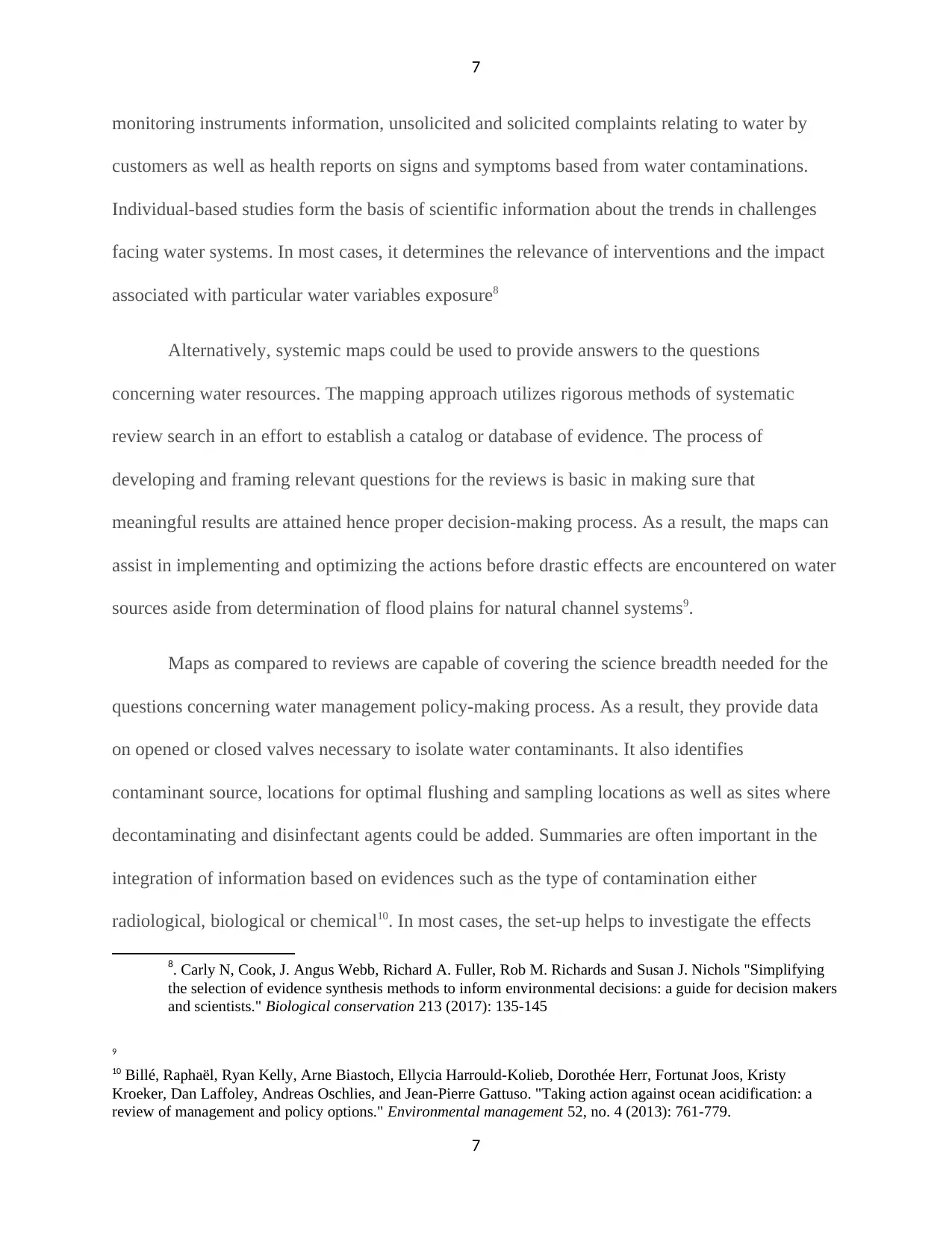
7
monitoring instruments information, unsolicited and solicited complaints relating to water by
customers as well as health reports on signs and symptoms based from water contaminations.
Individual-based studies form the basis of scientific information about the trends in challenges
facing water systems. In most cases, it determines the relevance of interventions and the impact
associated with particular water variables exposure8
Alternatively, systemic maps could be used to provide answers to the questions
concerning water resources. The mapping approach utilizes rigorous methods of systematic
review search in an effort to establish a catalog or database of evidence. The process of
developing and framing relevant questions for the reviews is basic in making sure that
meaningful results are attained hence proper decision-making process. As a result, the maps can
assist in implementing and optimizing the actions before drastic effects are encountered on water
sources aside from determination of flood plains for natural channel systems9.
Maps as compared to reviews are capable of covering the science breadth needed for the
questions concerning water management policy-making process. As a result, they provide data
on opened or closed valves necessary to isolate water contaminants. It also identifies
contaminant source, locations for optimal flushing and sampling locations as well as sites where
decontaminating and disinfectant agents could be added. Summaries are often important in the
integration of information based on evidences such as the type of contamination either
radiological, biological or chemical10. In most cases, the set-up helps to investigate the effects
8. Carly N, Cook, J. Angus Webb, Richard A. Fuller, Rob M. Richards and Susan J. Nichols "Simplifying
the selection of evidence synthesis methods to inform environmental decisions: a guide for decision makers
and scientists." Biological conservation 213 (2017): 135-145
9
10 Billé, Raphaël, Ryan Kelly, Arne Biastoch, Ellycia Harrould-Kolieb, Dorothée Herr, Fortunat Joos, Kristy
Kroeker, Dan Laffoley, Andreas Oschlies, and Jean-Pierre Gattuso. "Taking action against ocean acidification: a
review of management and policy options." Environmental management 52, no. 4 (2013): 761-779.
7
monitoring instruments information, unsolicited and solicited complaints relating to water by
customers as well as health reports on signs and symptoms based from water contaminations.
Individual-based studies form the basis of scientific information about the trends in challenges
facing water systems. In most cases, it determines the relevance of interventions and the impact
associated with particular water variables exposure8
Alternatively, systemic maps could be used to provide answers to the questions
concerning water resources. The mapping approach utilizes rigorous methods of systematic
review search in an effort to establish a catalog or database of evidence. The process of
developing and framing relevant questions for the reviews is basic in making sure that
meaningful results are attained hence proper decision-making process. As a result, the maps can
assist in implementing and optimizing the actions before drastic effects are encountered on water
sources aside from determination of flood plains for natural channel systems9.
Maps as compared to reviews are capable of covering the science breadth needed for the
questions concerning water management policy-making process. As a result, they provide data
on opened or closed valves necessary to isolate water contaminants. It also identifies
contaminant source, locations for optimal flushing and sampling locations as well as sites where
decontaminating and disinfectant agents could be added. Summaries are often important in the
integration of information based on evidences such as the type of contamination either
radiological, biological or chemical10. In most cases, the set-up helps to investigate the effects
8. Carly N, Cook, J. Angus Webb, Richard A. Fuller, Rob M. Richards and Susan J. Nichols "Simplifying
the selection of evidence synthesis methods to inform environmental decisions: a guide for decision makers
and scientists." Biological conservation 213 (2017): 135-145
9
10 Billé, Raphaël, Ryan Kelly, Arne Biastoch, Ellycia Harrould-Kolieb, Dorothée Herr, Fortunat Joos, Kristy
Kroeker, Dan Laffoley, Andreas Oschlies, and Jean-Pierre Gattuso. "Taking action against ocean acidification: a
review of management and policy options." Environmental management 52, no. 4 (2013): 761-779.
7
Paraphrase This Document
Need a fresh take? Get an instant paraphrase of this document with our AI Paraphraser
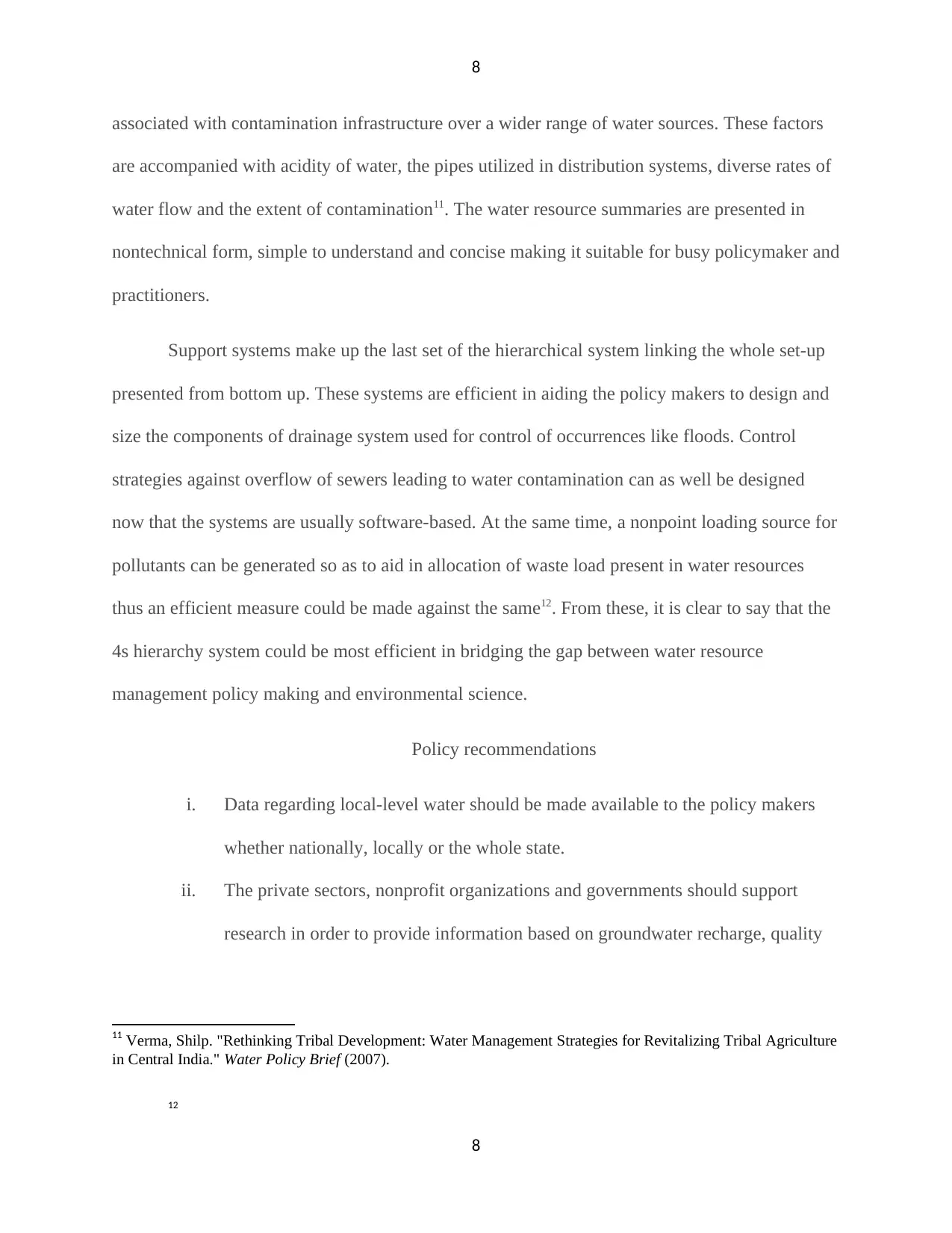
8
associated with contamination infrastructure over a wider range of water sources. These factors
are accompanied with acidity of water, the pipes utilized in distribution systems, diverse rates of
water flow and the extent of contamination11. The water resource summaries are presented in
nontechnical form, simple to understand and concise making it suitable for busy policymaker and
practitioners.
Support systems make up the last set of the hierarchical system linking the whole set-up
presented from bottom up. These systems are efficient in aiding the policy makers to design and
size the components of drainage system used for control of occurrences like floods. Control
strategies against overflow of sewers leading to water contamination can as well be designed
now that the systems are usually software-based. At the same time, a nonpoint loading source for
pollutants can be generated so as to aid in allocation of waste load present in water resources
thus an efficient measure could be made against the same12. From these, it is clear to say that the
4s hierarchy system could be most efficient in bridging the gap between water resource
management policy making and environmental science.
Policy recommendations
i. Data regarding local-level water should be made available to the policy makers
whether nationally, locally or the whole state.
ii. The private sectors, nonprofit organizations and governments should support
research in order to provide information based on groundwater recharge, quality
11 Verma, Shilp. "Rethinking Tribal Development: Water Management Strategies for Revitalizing Tribal Agriculture
in Central India." Water Policy Brief (2007).
12
8
associated with contamination infrastructure over a wider range of water sources. These factors
are accompanied with acidity of water, the pipes utilized in distribution systems, diverse rates of
water flow and the extent of contamination11. The water resource summaries are presented in
nontechnical form, simple to understand and concise making it suitable for busy policymaker and
practitioners.
Support systems make up the last set of the hierarchical system linking the whole set-up
presented from bottom up. These systems are efficient in aiding the policy makers to design and
size the components of drainage system used for control of occurrences like floods. Control
strategies against overflow of sewers leading to water contamination can as well be designed
now that the systems are usually software-based. At the same time, a nonpoint loading source for
pollutants can be generated so as to aid in allocation of waste load present in water resources
thus an efficient measure could be made against the same12. From these, it is clear to say that the
4s hierarchy system could be most efficient in bridging the gap between water resource
management policy making and environmental science.
Policy recommendations
i. Data regarding local-level water should be made available to the policy makers
whether nationally, locally or the whole state.
ii. The private sectors, nonprofit organizations and governments should support
research in order to provide information based on groundwater recharge, quality
11 Verma, Shilp. "Rethinking Tribal Development: Water Management Strategies for Revitalizing Tribal Agriculture
in Central India." Water Policy Brief (2007).
12
8
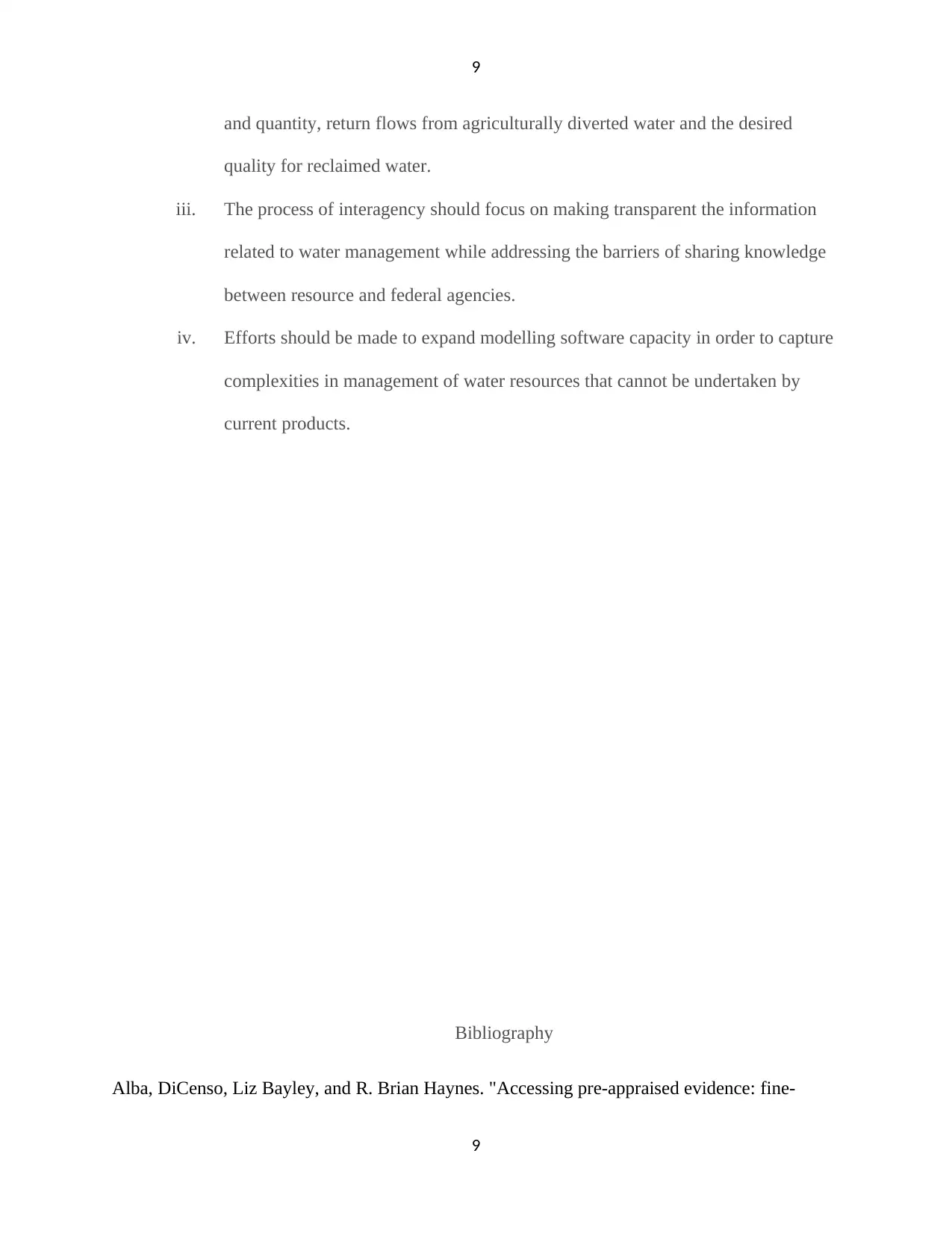
9
and quantity, return flows from agriculturally diverted water and the desired
quality for reclaimed water.
iii. The process of interagency should focus on making transparent the information
related to water management while addressing the barriers of sharing knowledge
between resource and federal agencies.
iv. Efforts should be made to expand modelling software capacity in order to capture
complexities in management of water resources that cannot be undertaken by
current products.
Bibliography
Alba, DiCenso, Liz Bayley, and R. Brian Haynes. "Accessing pre-appraised evidence: fine-
9
and quantity, return flows from agriculturally diverted water and the desired
quality for reclaimed water.
iii. The process of interagency should focus on making transparent the information
related to water management while addressing the barriers of sharing knowledge
between resource and federal agencies.
iv. Efforts should be made to expand modelling software capacity in order to capture
complexities in management of water resources that cannot be undertaken by
current products.
Bibliography
Alba, DiCenso, Liz Bayley, and R. Brian Haynes. "Accessing pre-appraised evidence: fine-
9
You're viewing a preview
Unlock full access by subscribing today!
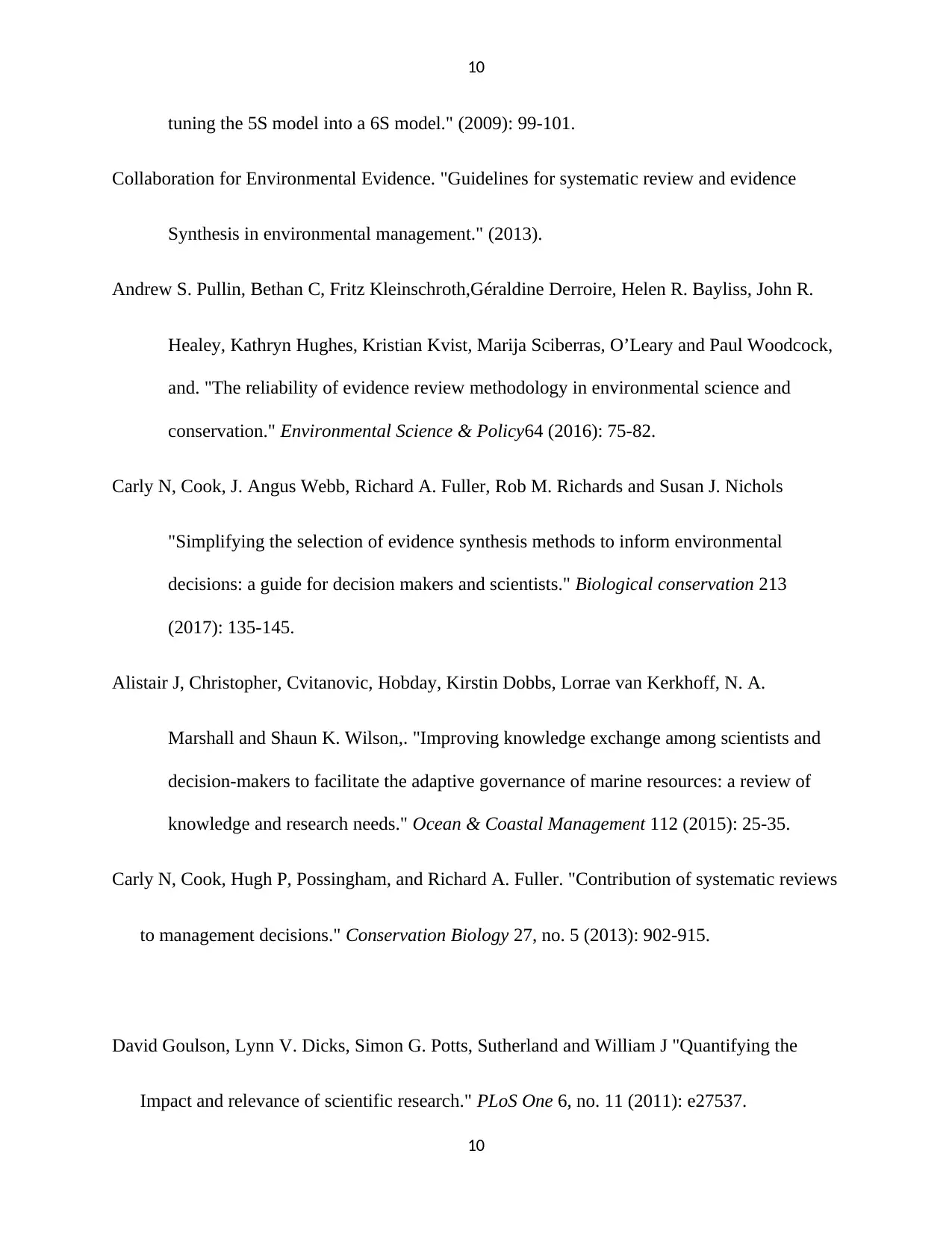
10
tuning the 5S model into a 6S model." (2009): 99-101.
Collaboration for Environmental Evidence. "Guidelines for systematic review and evidence
Synthesis in environmental management." (2013).
Andrew S. Pullin, Bethan C, Fritz Kleinschroth,Géraldine Derroire, Helen R. Bayliss, John R.
Healey, Kathryn Hughes, Kristian Kvist, Marija Sciberras, O’Leary and Paul Woodcock,
and. "The reliability of evidence review methodology in environmental science and
conservation." Environmental Science & Policy64 (2016): 75-82.
Carly N, Cook, J. Angus Webb, Richard A. Fuller, Rob M. Richards and Susan J. Nichols
"Simplifying the selection of evidence synthesis methods to inform environmental
decisions: a guide for decision makers and scientists." Biological conservation 213
(2017): 135-145.
Alistair J, Christopher, Cvitanovic, Hobday, Kirstin Dobbs, Lorrae van Kerkhoff, N. A.
Marshall and Shaun K. Wilson,. "Improving knowledge exchange among scientists and
decision-makers to facilitate the adaptive governance of marine resources: a review of
knowledge and research needs." Ocean & Coastal Management 112 (2015): 25-35.
Carly N, Cook, Hugh P, Possingham, and Richard A. Fuller. "Contribution of systematic reviews
to management decisions." Conservation Biology 27, no. 5 (2013): 902-915.
David Goulson, Lynn V. Dicks, Simon G. Potts, Sutherland and William J "Quantifying the
Impact and relevance of scientific research." PLoS One 6, no. 11 (2011): e27537.
10
tuning the 5S model into a 6S model." (2009): 99-101.
Collaboration for Environmental Evidence. "Guidelines for systematic review and evidence
Synthesis in environmental management." (2013).
Andrew S. Pullin, Bethan C, Fritz Kleinschroth,Géraldine Derroire, Helen R. Bayliss, John R.
Healey, Kathryn Hughes, Kristian Kvist, Marija Sciberras, O’Leary and Paul Woodcock,
and. "The reliability of evidence review methodology in environmental science and
conservation." Environmental Science & Policy64 (2016): 75-82.
Carly N, Cook, J. Angus Webb, Richard A. Fuller, Rob M. Richards and Susan J. Nichols
"Simplifying the selection of evidence synthesis methods to inform environmental
decisions: a guide for decision makers and scientists." Biological conservation 213
(2017): 135-145.
Alistair J, Christopher, Cvitanovic, Hobday, Kirstin Dobbs, Lorrae van Kerkhoff, N. A.
Marshall and Shaun K. Wilson,. "Improving knowledge exchange among scientists and
decision-makers to facilitate the adaptive governance of marine resources: a review of
knowledge and research needs." Ocean & Coastal Management 112 (2015): 25-35.
Carly N, Cook, Hugh P, Possingham, and Richard A. Fuller. "Contribution of systematic reviews
to management decisions." Conservation Biology 27, no. 5 (2013): 902-915.
David Goulson, Lynn V. Dicks, Simon G. Potts, Sutherland and William J "Quantifying the
Impact and relevance of scientific research." PLoS One 6, no. 11 (2011): e27537.
10
Paraphrase This Document
Need a fresh take? Get an instant paraphrase of this document with our AI Paraphraser
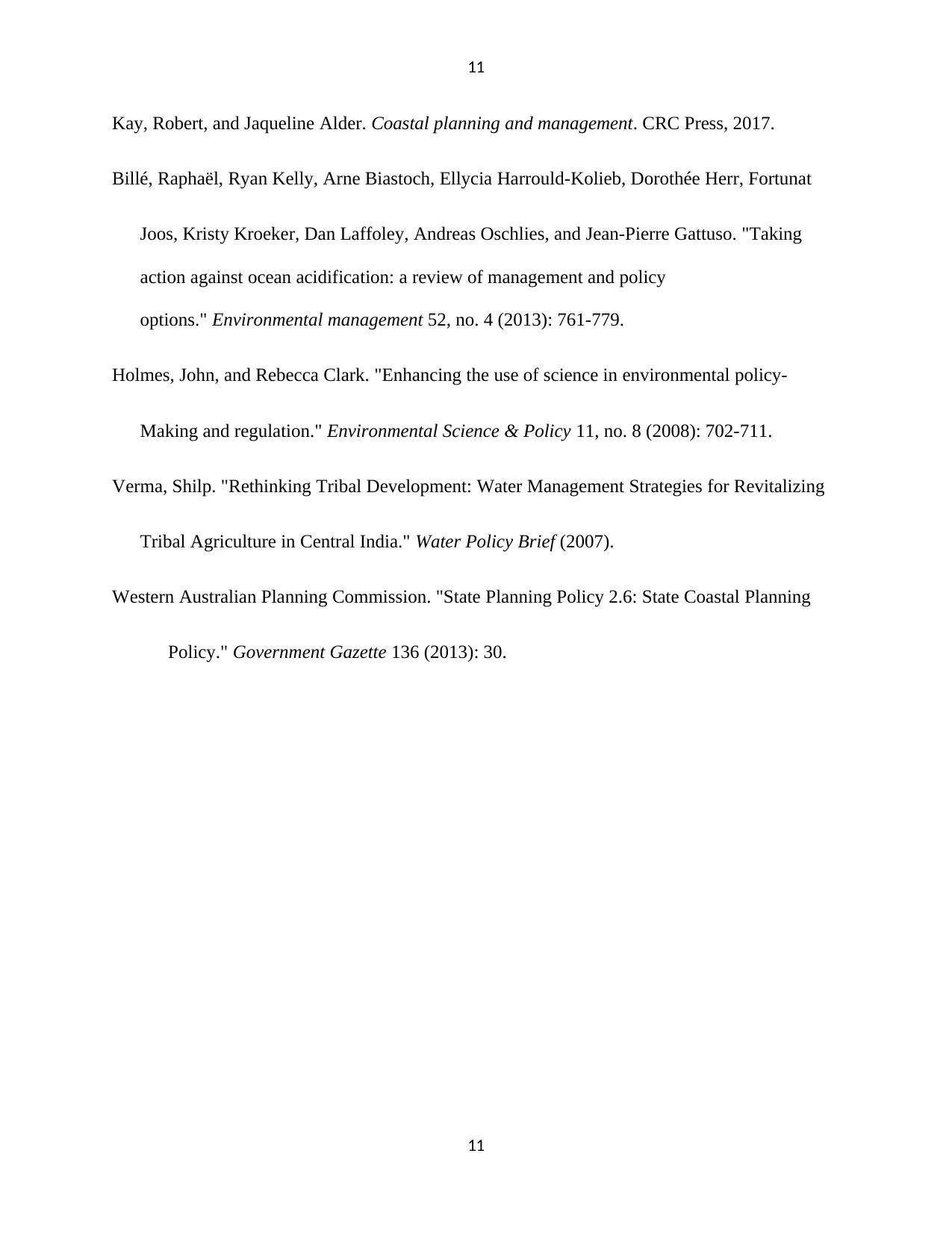
11
Kay, Robert, and Jaqueline Alder. Coastal planning and management. CRC Press, 2017.
Billé, Raphaël, Ryan Kelly, Arne Biastoch, Ellycia Harrould-Kolieb, Dorothée Herr, Fortunat
Joos, Kristy Kroeker, Dan Laffoley, Andreas Oschlies, and Jean-Pierre Gattuso. "Taking
action against ocean acidification: a review of management and policy
options." Environmental management 52, no. 4 (2013): 761-779.
Holmes, John, and Rebecca Clark. "Enhancing the use of science in environmental policy-
Making and regulation." Environmental Science & Policy 11, no. 8 (2008): 702-711.
Verma, Shilp. "Rethinking Tribal Development: Water Management Strategies for Revitalizing
Tribal Agriculture in Central India." Water Policy Brief (2007).
Western Australian Planning Commission. "State Planning Policy 2.6: State Coastal Planning
Policy." Government Gazette 136 (2013): 30.
11
Kay, Robert, and Jaqueline Alder. Coastal planning and management. CRC Press, 2017.
Billé, Raphaël, Ryan Kelly, Arne Biastoch, Ellycia Harrould-Kolieb, Dorothée Herr, Fortunat
Joos, Kristy Kroeker, Dan Laffoley, Andreas Oschlies, and Jean-Pierre Gattuso. "Taking
action against ocean acidification: a review of management and policy
options." Environmental management 52, no. 4 (2013): 761-779.
Holmes, John, and Rebecca Clark. "Enhancing the use of science in environmental policy-
Making and regulation." Environmental Science & Policy 11, no. 8 (2008): 702-711.
Verma, Shilp. "Rethinking Tribal Development: Water Management Strategies for Revitalizing
Tribal Agriculture in Central India." Water Policy Brief (2007).
Western Australian Planning Commission. "State Planning Policy 2.6: State Coastal Planning
Policy." Government Gazette 136 (2013): 30.
11
1 out of 11
Your All-in-One AI-Powered Toolkit for Academic Success.
+13062052269
info@desklib.com
Available 24*7 on WhatsApp / Email
![[object Object]](/_next/static/media/star-bottom.7253800d.svg)
Unlock your academic potential
© 2024 | Zucol Services PVT LTD | All rights reserved.